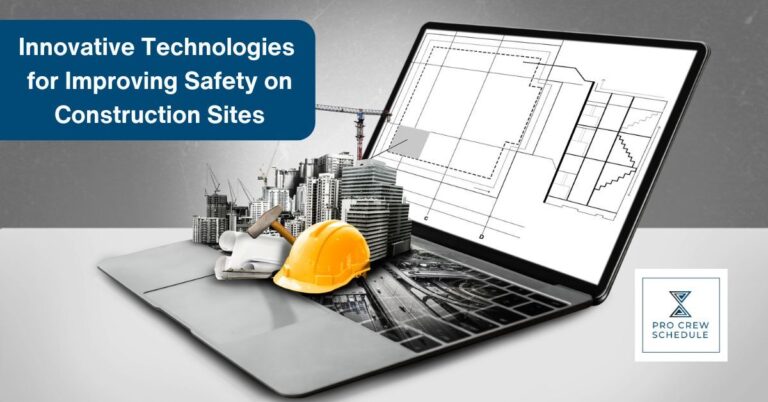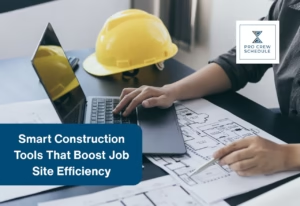The construction industry is undoubtedly one of the most dangerous places to work. Construction sites are complicated places to work since they involve many moving parts that pose many risks for workers. Falls, electrocution, being hit by something, getting caught in or between things, and other work-related accidents are some of the hazards that construction workers are frequently exposed to. Construction workers must know these risks and must take the appropriate steps to avoid them.
Another essential part of building site safety is communication. Your construction workers must be able to communicate clearly with each other and their bosses to find and deal with possible dangers. This kind of conversation can help keep the workplace safer and less likely to have accidents.
To ensure the safety of your building workers throughout the project, it is also essential to follow safety rules and give them the proper training. Employers must be able to provide workers with the right personal safety equipment (PPE) to keep them from getting hurt on the job. They also need to ensure that their PPE fits well and that they know how to use it properly.
This article will talk about some of the most common safety risks in construction and give you tips on how to efficiently and effectively avoid them. By using these tips and other safety measures, you, as the general contractor or the project manager, can lower the risk of getting hurt on the job and make sure everyone stays safe on the site.
What Are The Common Hazards in Construction?
In a nutshell, a building or construction site is any area of land where a project is being built or fixed up. Since you are dealing with various projects that can range in size, scope, and complexity, you may find yourself using a lot of big tools, equipment, and machines, working at heights, and being in many places with hazardous materials.
In this section, we will examine some of the usual dangers a construction worker may encounter on a building site. This list of hazards will help you understand the risks and figure out how to avoid them.
Working At Height
One of the top safety hazards in a construction site is working at a height, especially if you are completing high-rise buildings. Every year, about a quarter of all worker deaths are caused by falling from a high place. This means that working at heights is the most common way that workers die from their accidents.
All workers who work at heights must get the proper training and protective equipment. They should also be taught how to work safely on different surfaces and tools, such as scaffolding, ladders, and roofs.
It is critical to have a plan to ensure all the work is done safely and place safety measures around the job site. For example, you can add safety or guard rails to the gondola platform. Workers must have had the proper training and regulations to do their job at a height.
Falls, Slips, and Trips
People can slip, trip, and fall in almost any setting. Slips, trips, and falls happen frequently on construction sites because the ground is not always level, buildings are not finished yet, and materials are often not being used. People can fall off of roofs, ladders, platforms, and other high places. However, most of these accidents could have been avoided if working areas and access routes, like stairwells and footpaths, were better managed. To keep from falling, workers should always use the proper fall protection gear, like guardrails, safety nets, and belts.
Here are some things that can cause people to slip and trip and how to stop them:
Uneven surfaces
You can lower the risk of these by making sure walks are clearly marked as well-lit walkways and have good conditions underfoot.
Obstacles
Slipping and tripping over obstacles can be significantly reduced if everyone cleans up their work and storage areas and sets aside specific areas for trash collection.
Slippery Areas
The best way to treat a wet or slippery area is with stone if it is slippery from mud or grit if it is slippery from ice. Signs should be put up to show where the slick spots are, and shoes with good grip should be worn.
Electrocution
When managing construction, you will have to work with electricity. However, it can quickly become dangerous, so you need to learn how to do it right. Electricity wires and power lines should always be visible to workers, and they should never work near them.
Workers should also use insulated tools and wear safety gear like rubber gloves when working with electricity. You must provide your workers with the proper training to ensure they are adequately trained in electrical safety. This includes learning to spot possible electrical hazards and safely use electrical equipment. By following these rules and being careful around electricity, your workers can lower their chance of electrocution and other electrical accidents.
Struck-by Accidents
A struck-by accident can happen when a falling item, vehicle, or material equipment hits a worker. It is contingent on working at heights. To prevent these kinds of accidents, workers should always wear safety gear that makes them stand out. They should also consider their surroundings and avoid moving equipment and cars.
Workers need to be taught how to spot possible hazards that could hit them and safely move through work areas where things or vehicles could fall. At the same time, your workers should be able to secure all materials to ensure no accidents at the site. Having a presence of mind is critical so workers can avoid struck-by accidents and their possibly terrible effects.
Caught In Or Between Accidents
A person is caught in or caught between an accident when they are trapped or crushed between two things. These kinds of accidents can happen in trenches, excavations, or other small areas. To prevent these accidents, workers should use the proper techniques for digging and trenching, such as shoring, sloping, or benching.
Workers should never enter a confined area without the appropriate training and gear. They must know how to secure trenches and excavations properly and spot possible caught-in or caught-between hazards.
Injuries from Repetitive Motion
People often get injuries from doing the same thing over and over, like carpal tunnel syndrome. These accidents can happen if you do the same thing over and over, like using a jackhammer or a power tool. To avoid these accidents, workers should take breaks often and stretch their muscles frequently.
Try to equip your workers with ergonomic tools to keep them from having injuries. Train them as well on how to spot the early signs of repetitive motion injuries. By taking care of their bodies and using good ergonomics, workers can lower their risk of repetitive motion injuries and do their jobs more quickly and easily.
Construction Technology That Can Improve Safety
As mentioned in the earlier sections, the construction industry is renowned for its complexity and inherent risks. As a result, project managers have always prioritized safety. With the advent of innovative technologies, the potential to enhance safety on construction sites has significantly increased.
These technological advancements not only reduce the possibility of accidents but also promote a culture of health and safety to ensure that construction workers can perform their tasks in a safer environment.
In this section, let us look at some of the most impactful construction technologies that you can use for your operations.
Wearable Technology
Wearable devices, like intelligent helmets, vests, gloves, and boots, have emerged as powerful tools for Monitoring and enhancing worker safety. These simple yet powerful devices are equipped with various sensors that track parameters such as location, heart rate, body temperature, and movement.
Drones
Drones, or uncrewed aerial vehicles (UAVs), have revolutionized construction site safety by providing a bird’s-eye view of the site, enabling better Monitoring and inspection. This capability allows for thorough inspections without putting workers at risk in hazardous areas.
Regular drone flights can monitor construction progress, ensuring that safety protocols are being strictly enforced and followed and identifying potential safety risks early.
Virtual Reality (VR) and Augmented Reality (AR)
VR and AR technologies offer immersive training and real-time assistance, significantly enhancing safety training and operational safety on construction sites. It provides workers with realistic training experiences, allowing them to practice handling dangerous situations in a safe, controlled environment. This hands-on approach improves their preparedness for real-world scenarios.
Building Information Modeling (BIM)
BIM allows you to create a detailed visualization and digital representation of a construction project that encompasses all aspects of its project lifecycle. It can help you improve planning and communication and ensure a seamless delivery. It also has powerful features that identify potential hazards and allow you to plan for safety measures even before construction begins.
Robotics and Automation
The use of robots and automated systems can significantly reduce workers’ exposure to dangerous tasks, thereby enhancing overall site safety. For example, construction management software automates many tedious tasks, allowing you to place your focus on the more essential parts of the project.
IoT and Smart Sensors
The Internet of Things (IoT) and smart sensors provide real-time data that can be used to monitor and enhance safety on construction sites. It can continuously monitor environmental conditions such as air quality, temperature, noise levels, and vibrations. Alerts are generated when conditions become unsafe, allowing for immediate action.
Artificial Intelligence (AI) and Machine Learning
AI and machine learning algorithms analyze vast amounts of data to predict and prevent safety incidents on construction sites. AI uses algorithms to analyze historical data to identify patterns and predict potential safety incidents. This predictive capability allows for the implementation of preventive measures before accidents occur.
Mobile Applications
Mobile applications provide a convenient platform for managing safety on construction sites, offering various tools for communication, reporting, and Monitoring.







